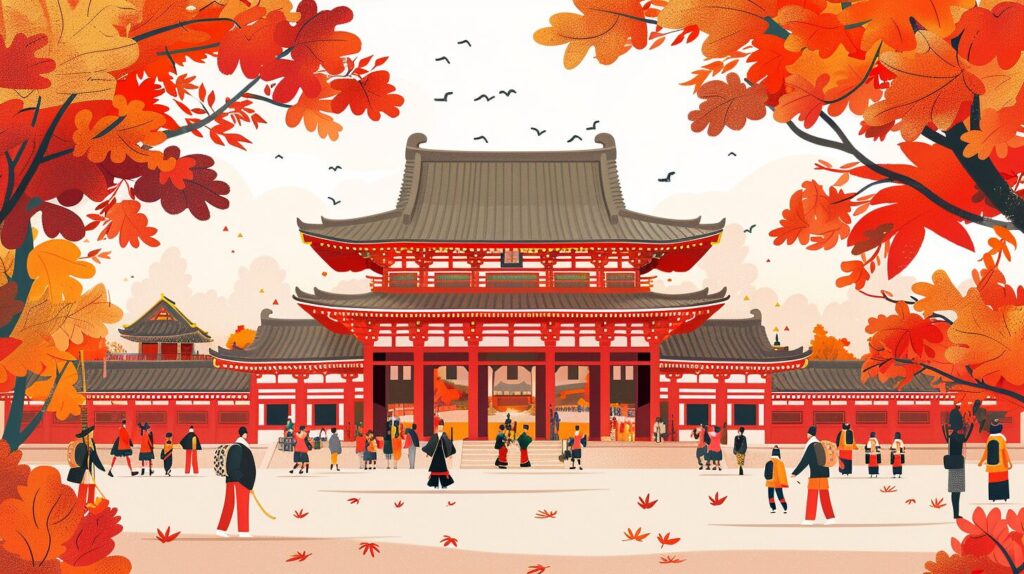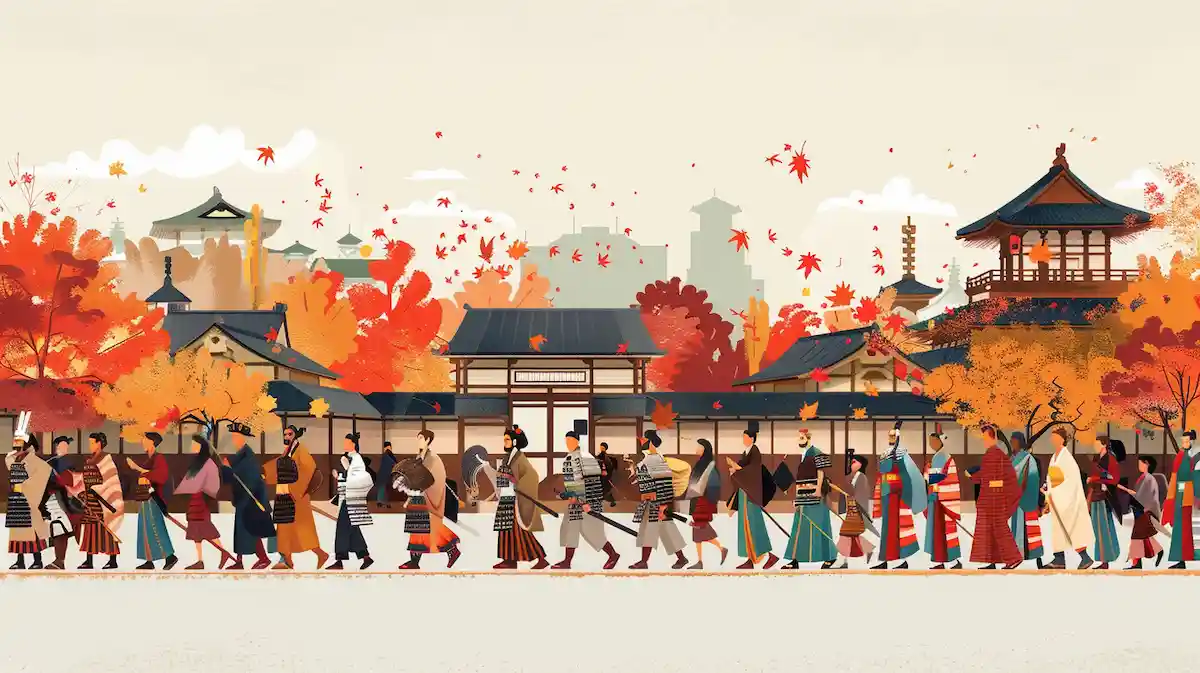時代祭を英語で説明・紹介するための基本情報と、英会話に役立つ表現をシンプルでわかりやすい英語で紹介します。
英会話ダイアローグ・関連情報・10の質問を通して、時代祭に関する英語表現を学びます。
英語
英会話ダイアローグを読む前に知っておくと良い前提知識と情報です。
- 時代祭とは:
- 京都の三大祭りの一つ、毎年10月22日に開催
- 京都が首都として創建されてから1100周年を記念して始まった
- パレードの特徴:
- 平安時代から明治時代までの日本の歴史を逆年代順で再現
- 京都御所から平安神宮までの約4.5キロメートルを行進
- 京都三大祭りの一つ:
- 祇園祭(7月)、葵祭(5月)と並んで京都三大祭りの一つ
2人が時代祭について話しています。
京都三大祭りの時代祭の起源や目的、パレードの特徴、参加者数やルート、見どころなどを話題にしています。
会話 / dialogue

Hey Key, I’ve been reading a lot about the Jidai Matsuri lately. I’m really interested in it and want to learn more. Have you ever been to it?

Yes, I’ve been a couple of times. It’s one of Kyoto’s three major festivals, along with the Gion Matsuri and Aoi Matsuri. The Jidai Matsuri is fascinating because it’s like a live history lesson.

I read that it started in 1895. Do you know why it was created?

Absolutely. It was created to celebrate the 1,100th anniversary of Kyoto’s founding as the capital of Japan. The Heian Shrine, where the festival ends, was also built for this occasion. They wanted to honor Kyoto’s rich history, especially since the capital had moved to Tokyo in 1868 during the Meiji Restoration.

That’s interesting! I also learned that the parade goes in reverse chronological order, starting from the Meiji period and going back to the Heian period. Why do they do it that way?

It’s designed to take viewers on a journey back in time. You start with the most recent history and then go deeper into the past, all the way back to when Kyoto became the capital. It really emphasizes how much history Kyoto holds.

The parade sounds like a highlight. About 2,000 people participate, right?

Yes, and they’re all dressed in period costumes. The detail is incredible—everything from the samurai armor to the noblewomen’s kimonos is meticulously crafted. The parade covers about 4.5 kilometers, starting at the Kyoto Imperial Palace and ending at the Heian Shrine.

How long does it take?

The whole procession takes about 2 to 2.5 hours. It’s a slow, majestic march, so you can really take in the sights.

What do you think is the most interesting part of the parade?

I’d say the variety. You get to see different eras of Japanese history represented, from the warriors of the Kamakura period to the court nobles of the Heian period. It’s like watching Japan’s history unfold right in front of you.

I also read that the festival helps preserve Kyoto’s cultural influence, even after the capital moved to Tokyo. That’s pretty significant, isn’t it?

Exactly. The Jidai Matsuri plays a big role in keeping Kyoto’s history alive and passing it on to future generations. It’s more than just a parade; it’s a way for the city to maintain its identity and heritage.

I’m definitely planning to go next year. It sounds like an amazing way to experience Kyoto’s history firsthand.

You should! It’s an unforgettable experience. Just make sure to arrive early to get a good spot along the parade route.

Thanks for the tips, Key. I’m really excited to see it in person.

You’ll love it. It’s one of those events that really connects you to Japan’s past in a meaningful way.
概要(時代祭の歴史・見どころ・重要性)
「時代祭」について、理解を深めるための「英語での関連情報」です。
時代祭

What is the Jidai Matsuri?
The Jidai Matsuri, or “Festival of the Ages,” is one of Kyoto’s most important festivals. It takes place every year on October 22nd. The festival started in 1895 to celebrate the 1,100th anniversary of Kyoto becoming the capital of Japan. It was created to honor Kyoto’s rich history, especially after the capital moved to Tokyo during the Meiji Restoration in 1868.
The Parade
The highlight of the Jidai Matsuri is a grand parade. Around 2,000 people dress in traditional costumes from different periods of Japanese history. The parade goes in reverse chronological order, starting from the Meiji period and going back to the Heian period. It begins at the Kyoto Imperial Palace and ends at the Heian Shrine, covering about 4.5 kilometers.
Importance of the Festival
The Jidai Matsuri is more than just a parade; it is a way to preserve and celebrate Kyoto’s cultural heritage. It helps maintain Kyoto’s historical significance and connects people with Japan’s past. The festival is one of Kyoto’s three major festivals, along with the Gion Matsuri and Aoi Matsuri, and attracts many visitors every year.
10の質問(時代祭を知るための基本知識)
「時代祭」について、理解を深めるための「英語での10の質問」です。
1: What is the Jidai Matsuri?
The Jidai Matsuri is a historical festival in Kyoto, held every year on October 22nd. It celebrates Kyoto’s long history, particularly the 1,100th anniversary of its founding as the capital of Japan.
2: When did the Jidai Matsuri start?
The Jidai Matsuri began in 1895 to commemorate the 1,100th anniversary of Kyoto becoming Japan’s capital.
3: What is the main event of the Jidai Matsuri?
The main event of the Jidai Matsuri is a large parade with about 2,000 participants wearing costumes from different periods of Japanese history, from the Meiji period back to the Heian period.
4: Where does the Jidai Matsuri parade take place?
The parade starts at the Kyoto Imperial Palace and ends at the Heian Shrine, covering a route of about 4.5 kilometers.
5: How long does the Jidai Matsuri parade take?
The parade usually takes about 2 to 2.5 hours to complete.
6: What is the purpose of the Jidai Matsuri?
The purpose of the Jidai Matsuri is to honor Kyoto’s history and cultural heritage, and to preserve the traditions and historical significance of the city.
7: What eras are represented in the Jidai Matsuri parade?
The parade represents various periods of Japanese history, including the Meiji, Edo, Azuchi-Momoyama, Muromachi, Kamakura, and Heian periods.
8: Why does the Jidai Matsuri parade go in reverse chronological order?
The parade goes in reverse chronological order to take viewers on a journey back in time, from the most recent history to the earliest days of Kyoto as the capital.
9: Is the Jidai Matsuri part of Kyoto’s major festivals?
Yes, the Jidai Matsuri is one of Kyoto’s three major festivals, along with the Gion Matsuri and Aoi Matsuri.
10: What is the significance of the Heian Shrine in the Jidai Matsuri?
The Heian Shrine is significant because it was built in 1895 as part of the celebration of Kyoto’s 1,100th anniversary, and it serves as the endpoint of the Jidai Matsuri parade.

和訳付
会話 / dialogue

Hey Key, I’ve been reading a lot about the Jidai Matsuri lately. I’m really interested in it and want to learn more. Have you ever been to it?
ねえ、キー。最近、時代祭についていろいろ調べてるんだ。すごく興味が湧いてきて、もっと知りたいんだ。行ったことある?

Yes, I’ve been a couple of times. It’s one of Kyoto’s three major festivals, along with the Gion Matsuri and Aoi Matsuri. The Jidai Matsuri is fascinating because it’s like a live history lesson.
うん、何度か行ったことあるよ。時代祭は祇園祭と葵祭と並んで、京都の三大祭りの一つだよ。時代祭って、生きた歴史の授業みたいで面白いんだよね。

I read that it started in 1895. Do you know why it was created?
1895年に始まったって読んだんだけど、なんで始まったのか知ってる?

Absolutely. It was created to celebrate the 1,100th anniversary of Kyoto’s founding as the capital of Japan. The Heian Shrine, where the festival ends, was also built for this occasion. They wanted to honor Kyoto’s rich history, especially since the capital had moved to Tokyo in 1868 during the Meiji Restoration.
もちろん。これは、京都が日本の首都になってから1100周年を祝うために始まったんだ。祭りが終わる平安神宮も、この時に建てられたんだよ。特に、明治維新で1868年に首都が東京に移った後、京都の豊かな歴史を称えたかったんだ。

That’s interesting! I also learned that the parade goes in reverse chronological order, starting from the Meiji period and going back to the Heian period. Why do they do it that way?
それは興味深いね!パレードが逆の年代順で進むって知ったよ。明治時代から始まって平安時代まで遡るんだよね。なんでそんな順番なんだろう?

It’s designed to take viewers on a journey back in time. You start with the most recent history and then go deeper into the past, all the way back to when Kyoto became the capital. It really emphasizes how much history Kyoto holds.
それは観客を時間旅行に連れて行くためなんだ。最近の歴史から始まって、どんどん過去に遡っていく。最後は京都が首都になった時代に戻るんだよ。京都がいかに歴史を持っているかを強調しているんだ。

The parade sounds like a highlight. About 2,000 people participate, right?
パレードが見どころみたいだね。約2000人が参加するんだよね?

Yes, and they’re all dressed in period costumes. The detail is incredible—everything from the samurai armor to the noblewomen’s kimonos is meticulously crafted. The parade covers about 4.5 kilometers, starting at the Kyoto Imperial Palace and ending at the Heian Shrine.
そうだよ。しかもみんなが時代衣装を着ているんだ。細部までこだわっていて、侍の鎧から貴族の女性の着物まで、全てが精巧に作られているんだ。パレードは京都御所から始まって、平安神宮まで約4.5キロメートルを進むんだよ。

How long does it take?
どれくらい時間がかかるの?

The whole procession takes about 2 to 2.5 hours. It’s a slow, majestic march, so you can really take in the sights.
全体で2時間から2時間半くらいかかるよ。ゆっくりとした荘厳な行進だから、しっかりと見られるんだ。

What do you think is the most interesting part of the parade?
パレードの中で一番面白い部分はどこだと思う?

I’d say the variety. You get to see different eras of Japanese history represented, from the warriors of the Kamakura period to the court nobles of the Heian period. It’s like watching Japan’s history unfold right in front of you.
そうだね、バラエティかな。鎌倉時代の武士から平安時代の宮廷貴族まで、日本のさまざまな時代を見られるんだ。日本の歴史が目の前で展開されているような感じだよ。

I also read that the festival helps preserve Kyoto’s cultural influence, even after the capital moved to Tokyo. That’s pretty significant, isn’t it?
それに、首都が東京に移っても京都の文化的影響力を維持するためにも、この祭りが役立っているって読んだんだけど。それって結構重要だよね?

Exactly. The Jidai Matsuri plays a big role in keeping Kyoto’s history alive and passing it on to future generations. It’s more than just a parade; it’s a way for the city to maintain its identity and heritage.
その通り。時代祭は、京都の歴史を生き生きと保ち、次の世代に伝える上で大きな役割を果たしているんだ。ただのパレードじゃなくて、街が自分たちのアイデンティティと遺産を守る方法なんだよ。

I’m definitely planning to go next year. It sounds like an amazing way to experience Kyoto’s history firsthand.
来年は絶対に行くつもりだよ。京都の歴史を直接体験する素晴らしい方法みたいだね。

You should! It’s an unforgettable experience. Just make sure to arrive early to get a good spot along the parade route.
ぜひ行ってみて!忘れられない経験になるよ。パレードのルートに沿った良い場所を確保するために、早めに行くようにね。

Thanks for the tips, Key. I’m really excited to see it in person.
アドバイスありがとう、キー。実際に見るのがすごく楽しみだよ。

You’ll love it. It’s one of those events that really connects you to Japan’s past in a meaningful way.
きっと気に入るよ。この祭りは、日本の過去に深くつながることができる貴重なイベントの一つだよ。
概要(時代祭の歴史・見どころ・重要性)
時代祭

What is the Jidai Matsuri?
The Jidai Matsuri, or “Festival of the Ages,” is one of Kyoto’s most important festivals. It takes place every year on October 22nd. The festival started in 1895 to celebrate the 1,100th anniversary of Kyoto becoming the capital of Japan. It was created to honor Kyoto’s rich history, especially after the capital moved to Tokyo during the Meiji Restoration in 1868.
時代祭は、「時代祭」として知られる京都の最も重要な祭りの一つです。毎年10月22日に開催されます。この祭りは、京都が日本の首都になってから1100周年を祝うために、1895年に始まりました。特に、1868年の明治維新で首都が東京に移った後、京都の豊かな歴史を称えるために創設されました。
The Parade
The highlight of the Jidai Matsuri is a grand parade. Around 2,000 people dress in traditional costumes from different periods of Japanese history. The parade goes in reverse chronological order, starting from the Meiji period and going back to the Heian period. It begins at the Kyoto Imperial Palace and ends at the Heian Shrine, covering about 4.5 kilometers.
時代祭の見どころは壮大なパレードです。約2,000人が日本の歴史のさまざまな時代の伝統衣装を着用します。パレードは逆の年代順で進み、明治時代から始まり、平安時代まで遡ります。パレードは京都御所から始まり、平安神宮で終了し、約4.5キロメートルを進みます。
Importance of the Festival
The Jidai Matsuri is more than just a parade; it is a way to preserve and celebrate Kyoto’s cultural heritage. It helps maintain Kyoto’s historical significance and connects people with Japan’s past. The festival is one of Kyoto’s three major festivals, along with the Gion Matsuri and Aoi Matsuri, and attracts many visitors every year.
時代祭は単なるパレードではなく、京都の文化遺産を保存し、祝うための方法です。この祭りは、京都の歴史的重要性を維持し、人々を日本の過去と結びつける役割を果たしています。時代祭は祇園祭と葵祭と並んで京都の三大祭りの一つで、毎年多くの訪問者を引きつけています。
10の質問(時代祭を知るための基本知識)
1: What is the Jidai Matsuri?
時代祭とは何ですか?
The Jidai Matsuri is a historical festival in Kyoto, held every year on October 22nd. It celebrates Kyoto’s long history, particularly the 1,100th anniversary of its founding as the capital of Japan.
時代祭は、京都で毎年10月22日に開催される歴史的な祭りです。特に、京都が日本の首都として創設されてから1100周年を祝うものです。
2: When did the Jidai Matsuri start?
時代祭はいつ始まりましたか?
The Jidai Matsuri began in 1895 to commemorate the 1,100th anniversary of Kyoto becoming Japan’s capital.
時代祭は、1895年に京都が日本の首都になってから1100周年を記念して始まりました。
3: What is the main event of the Jidai Matsuri?
時代祭の主なイベントは何ですか?
The main event of the Jidai Matsuri is a large parade with about 2,000 participants wearing costumes from different periods of Japanese history, from the Meiji period back to the Heian period.
時代祭の主なイベントは、大規模なパレードで、約2000人が明治時代から平安時代までの日本の歴史を再現した衣装を着ています。
4: Where does the Jidai Matsuri parade take place?
時代祭のパレードはどこで行われますか?
The parade starts at the Kyoto Imperial Palace and ends at the Heian Shrine, covering a route of about 4.5 kilometers.
パレードは京都御所から始まり、平安神宮で終わり、約4.5キロメートルのルートを進みます。
5: How long does the Jidai Matsuri parade take?
時代祭のパレードはどれくらい時間がかかりますか?
The parade usually takes about 2 to 2.5 hours to complete.
パレードは通常、約2時間から2時間半かかります。
6: What is the purpose of the Jidai Matsuri?
時代祭の目的は何ですか?
The purpose of the Jidai Matsuri is to honor Kyoto’s history and cultural heritage, and to preserve the traditions and historical significance of the city.
時代祭の目的は、京都の歴史と文化遺産を称え、街の伝統と歴史的重要性を保存することです。
7: What eras are represented in the Jidai Matsuri parade?
時代祭のパレードではどの時代が再現されていますか?
The parade represents various periods of Japanese history, including the Meiji, Edo, Azuchi-Momoyama, Muromachi, Kamakura, and Heian periods.
パレードでは、明治、江戸、安土桃山、室町、鎌倉、そして平安時代など、日本のさまざまな歴史的な時代が再現されています。
8: Why does the Jidai Matsuri parade go in reverse chronological order?
時代祭のパレードが逆の年代順で進むのはなぜですか?
The parade goes in reverse chronological order to take viewers on a journey back in time, from the most recent history to the earliest days of Kyoto as the capital.
パレードが逆の年代順で進むのは、観客を最新の歴史から京都が首都となった最初の時代までの時間旅行に連れて行くためです。
9: Is the Jidai Matsuri part of Kyoto’s major festivals?
時代祭は京都の主要な祭りの一つですか?
Yes, the Jidai Matsuri is one of Kyoto’s three major festivals, along with the Gion Matsuri and Aoi Matsuri.
はい、時代祭は祇園祭や葵祭と並んで、京都の三大祭りの一つです。
10: What is the significance of the Heian Shrine in the Jidai Matsuri?
時代祭における平安神宮の重要性は何ですか?
The Heian Shrine is significant because it was built in 1895 as part of the celebration of Kyoto’s 1,100th anniversary, and it serves as the endpoint of the Jidai Matsuri parade.
平安神宮は、1895年に京都の1100周年を祝う一環として建てられ、時代祭のパレードの終点として重要です。
words & phrases
英会話ダイアローグと関連情報に出てきた単語・フレーズです(例文は各3つ)。

chronological : 形容詞
意味: 時系列の、年代順の。Arranged in the order in which events happened in time.
(時代祭のパレードが逆年代順に進む様子を説明するために使用)
例文:
- The events were listed in chronological order.
「出来事は時系列順に列挙されていました。」 - We need to organize these files in chronological order.
「これらのファイルを年代順に整理する必要があります。」 - The story is told in chronological order, starting from his childhood.
「物語は彼の幼少期から始まり、年代順に語られています。」
meticulously : 副詞
意味: 細心の注意を払って、注意深く。In a way that shows great attention to detail; very carefully and precisely.
(時代祭の衣装が細部にわたり精巧に作られている様子を説明するために使用)
例文:
- She meticulously planned every detail of the wedding.
「彼女は結婚式のすべての細部を細心の注意を払って計画しました。」 - The model was meticulously crafted by hand.
「モデルは手作業で注意深く作られました。」 - He meticulously checked his work for any errors.
「彼はエラーがないかを細かくチェックしました。」
procession : 名詞
意味: 行列、行進。A line or group of people or vehicles moving forward in an orderly, often ceremonial way.
(時代祭のパレードが行列として進む様子を説明するために使用)
例文:
- The wedding procession moved slowly through the streets.
「結婚式の行列がゆっくりと通りを進みました。」 - A procession of cars followed the hearse to the cemetery.
「車の行列が霊柩車に続いて墓地へ向かいました。」 - The festival included a procession of dancers and musicians.
「祭りにはダンサーと音楽家の行列が含まれていました。」
take in the sights : フレーズ
意味: 観光する、見物する。To visit and see the famous or interesting sights of a place.
(時代祭のパレードを見ながら観光を楽しむ様子を説明するために使用)
例文:
- We spent the afternoon taking in the sights of the city.
「私たちは午後、街の観光を楽しみました。」 - Tourists flocked to the area to take in the sights.
「観光客は見物するためにその地域に集まりました。」 - She plans to take in the sights while visiting Paris.
「彼女はパリを訪れた際に観光する予定です。」
unfold : 動詞
意味: 展開する、広がる。To develop, reveal, or be revealed gradually.
(時代祭のパレードが進行し、歴史が目の前で展開される様子を説明するために使用)
例文:
- The drama unfolded slowly, keeping the audience in suspense.
「ドラマはゆっくりと展開し、観客をハラハラさせました。」 - As the story unfolded, the mystery became clearer.
「物語が展開するにつれて、謎が明らかになりました。」 - She watched the events unfold from her window.
「彼女は窓から出来事が展開するのを見守っていました。」
